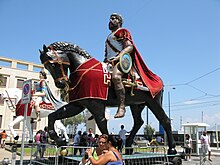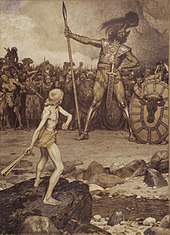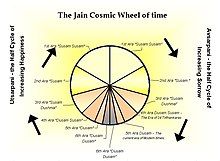Giant
This article may need to be rewritten to comply with Wikipedia's quality standards. (August 2019) |

In
Literary and cultural analysis
Giants appear many times in folklore and myths. Representing the human body enlarged to the point of being monstrous, giants evoke terror and remind humans of their body's frailty and mortality. They are often portrayed as monsters and antagonists, but there are exceptions. Some giants intermingle with humans in a friendly way and can even be part of human families with their offspring being portrayed as regular humans where they are often referred to as half-giants.[3]
Folklorists and historians examine the role giants are assigned in regional
Archeology and paleontology
Religion and mythology
Abrahamic
The Book of Numbers[10] includes the discouraging report by the spies sent by Moses into Canaan: "We can't attack those people; they are stronger than we are. (...) All the people we saw there are of great size. We saw the Nephilim there (the descendants of Anak come from the Nephilim). We seemed like grasshoppers in our own eyes, and we looked the same to them." However, the Book of Joshua, describing the actual conquest of Canaan in a later generation, makes no reference to such people living there.

The Bible also tells of
Josephus also described the Amorites as giants in his Antiquities of the Jews, circa 93 CE, indicating that some sort of fossils may have been on display at that time:[18] "For which reason they removed their camp to Hebron; and when they had taken it, they slew all the inhabitants. There were till then left the race of giants, who had bodies so large, and countenances so entirely different from other men, that they were surprising to the sight, and terrible to the hearing. The bones of these men are still shown to this very day, unlike to any credible relations of other men."[19]
The Book of Enoch describes giants as the offspring of Watchers and women in 7:2.[20]
Armenian
Hayk was known as the founder of the Armenian state. Hayk was part of a race of giants who helped construct the Tower of Babel. Ancient historian Movses Khorenatsi wrote, "Hayk was handsome and personable, with curly hair, sparkling eyes and strong arms. Among the giants he was the bravest and most famous, opponent of all who raised their hand to become absolute ruler over the giants and heroes."[21]
Mount Nemrut is known to have received its name from an Armenian tradition in which Nimrod was killed by an arrow shot by Hayk during a massive battle between two rival armies of giants to the south-east of Lake Van.[22]
Aztec
Aztec mythology features the Quinametzin, a race of giant men created in one of the previous solar eras. They are credited with the construction of Teotihuacan.
Basque
Giants are rough but generally righteous characters of formidable strength living in the hills of the Basque Country. Giants stand for the Basque people reluctant to convert to Christianity who decide to stick to the old lifestyle and customs in the forest. Sometimes they hold the secret of ancient techniques and wisdom unknown to the Christians, like in the legend of San Martin Txiki, while their most outstanding feature is their strength. It follows that in many legends all over the Basque territory the giants are held accountable for the creation of many stone formations, hills and ages-old megalithic structures (dolmens, etc.), with similar explanations provided in different spots.
However, giants show different variants and forms, they are most frequently referred to as jentilak and mairuak, while as individuals they can be represented as Basajaun ("the lord of the forests"), Sanson (variation of the biblical Samson), Errolan (based on the Frankish army general Roland who fell dead at the Battle of Roncevaux Pass) or even Tartalo (a one-eyed giant akin to the Greek Cyclops Polyphemus).
Bulgarian
In
Chilean
There are tales of giants in the northern Chilean port town of Caldera telling of giants who play with ships moving them from one port to another.[24] Tales of the same area also tells of giants who are able to crush humans with their feet and when laying down to sleep being so long as to reach from the mountains to the sea.[24] In some stories the giants are black humanoids or black bulls.[24] In southern Chile there are stories of giants said to belong to certain volcanoes such as Calbuco and Osorno.[24]
The
Greek
In
The Cyclopes are also compared to giants due to their huge size (e.g. Polyphemus, son of Poseidon and Thoosa and nemesis of Odysseus in Homer's The Odyssey). The Elder Cyclopes were the children of Gaia and Uranus, and later made Zeus' "master thunderbolt", Poseidon's trident, and Hades' "helm of darkness", during the Titanomachy.
The Hecatoncheires are giants that have 100 arms and 50 heads who were also the children of Gaia and Uranus.
Other known giant races in Greek mythology include the six-armed Gegeines, the northern Hyperboreans, and the cannibalistic Laestrygonians.
Hindu
There are accounts stating humans grew to the size of giants during the Satya Yuga, the first of the four cyclical ages (yugas) in the Hindu reckoning of time.[26]
Jain
According to Jainism, there was a time when giants walked upon this earth.[27][28] Jain cosmology divides the worldly cycle of time into two parts or half-cycles, avasarpani (age of descending purity) and ascending (utsarpani).[29]

According to
| Name of the Ara | Degree of happiness | Duration of Ara | Average height of people | Average lifespan of people |
| Sukhama-sukhamā | Utmost happiness and no sorrow | 400 trillion sāgaropamas | Six miles tall | Three palyopama years |
| Sukhamā | Moderate happiness and no sorrow | 300 trillion sāgaropamas | Four miles tall | Two palyopama Years |
| Sukhama-dukhamā | Happiness with very little sorrow | 200 trillion sāgaropamas | Two miles tall | One palyopama years |
| Dukhama-sukhamā | Happiness with little sorrow | 100 trillion sāgaropamas | 1500 meters | 705.6 quintillion years |
| Dukhamā | Sorrow with very little Happiness | 21,000 years | 6 feet | 130 years maximum |
| Dukhama- dukhamā | Extreme sorrow and misery | 21,000 years | 2 feet | 16–20 years |
Norse
In
Trolls are beings that are sometimes very large. The name troll is applied to jötnar.
An old Icelandic legend says that two night-prowling giants, a man and a woman, were traversing the fjord near Drangey Island with their cow when they were surprised by the bright rays of daybreak. As a result of exposure to daylight, all three were turned into stone. Drangey represents the cow and Kerling (supposedly the female giant, the name means "old hag") is to the south of it. Karl (the male giant) was to the north of the island, but he disappeared long ago.
A bergrisi – the traditional protector of southwestern Iceland – appears as a supporter on the coat of arms of Iceland.
Paiute
According to
Roman
Several Jupiter-Giant-Columns have been found in Germania Superior. These were crowned with a statue of Jupiter, typically on horseback, defeating or trampling down a giant, often depicted as a snake. They are restricted to the area of south-western Germany, western Switzerland, French Jura, and Alsace.
Other European

In
In the Netherlands, giants are often associated with creating or forming the landscape. For instance, two giants are said to have dug a channel, until they reached the village of Akkrum, where they had an argument and each went his own way, thus splitting the channel into two separate waterways. Others threw up hills, or became hills themselves when they died on the spot. In several legends, giants were evil beings that threatened, robbed and killed travellers or locals; such as Ellert and Brammert, in the province of Drenthe.
Medieval
Tales of combat with giants were a common feature in the folklore of the
Many giants in
Giants figure in folklore and fairy tales, such as Jack the Giant Killer, The Giant Who Had No Heart in His Body, Nix Nought Nothing, Robin Hood and the Prince of Aragon, Young Ronald, and Paul Bunyan. Ogres are humanoid creatures, sometimes of gigantic stature, that occur in various sorts of European folklore.
Rübezahl, is a kind giant from German folklore who lived in the Giant Mountains, along with the Bergmönch, a giant mountain spirit.[36]
Antero Vipunen is a giant shaman that appears in the Kalevala, meeting the epic hero Väinämöinen to teach him creation spells.[37]
Names
- Amorites - Hebrew Bible
- Anakim - Hebrew Bible
- Asura - Indian religions
- Behemoth - Hebrew Folklore
- Druon Antigoon - Dutch folklore
- Brân the Blessed - Welsh mythology
- Cewri - Welsh mythology
- Cormoran - Cornish mythology
- Cyclopes - Greek mythology
- Daidarabotchi - Japanese mythology
- Daitya - Hinduism
- Fomorians - Irish mythology
- Gigantes - Greek mythology
- Gog - Hebrew Bible
- Gogmagog - Matter of Britain
- Book of Samuel
- Humbaba - Sumerian religion
- Ispolin - Slavic paganism
- Jentil - Basque mythology
- Jötunn - Germanic mythology
- Kalevipoeg - Estonian mythology
- Majitu - Swahili people
- Nephilim - Hebrew Bible
- Og - Book of Numbers
- Ogre - European folklore
- Paul Bunyan - American folklore
- Quinametzin - Aztec mythology
- Rakshasa - Indian religions
- Rephaite - Hebrew Bible
- Rübezahl - German folklore/Czech folklore
- Paiute mythology
- Stallo - Sámi shamanism
- Tepegöz - Turkic mythology
- Teutobochus - Germanic mythology
- Titans - Greek mythology
- Toell the Great - Estonian mythology
- Trolls - Nordic folklore
- Uriaș - Romanian folklore
- Ysbaddaden - Welsh mythology
See also
References
- ^ Robert, of Gloucester; Wright, William Aldis (1887). The metrical chronicle of Robert of Gloucester. University of California Libraries. London : Printed for H.M. Stationery off., by Eyre and Spottiswoode. p. 25.
- ^ γίγαντες, Georg Autenrieth, A Homeric Dictionary, on Perseus Digital Library
- ISBN 978-1-317-04425-3.
- ^ "Geomythology. Giant's Causeway – the mythical stone way". Tectonics and Structural Geology. Retrieved 2023-05-17.
- JSTOR 41155003.
- ISSN 0015-587X.
- ^ ISBN 9780226112923.
- ^ Smith, P. J. (2019). Parody and Appropriation of the Past in the Grandes Chroniques Gargantuines and in Rabelais’s Pantagruel (1532). In K. A. E. Enenkel & K. A. Ottenheym (Eds.), The Quest for an Appropriate Past in Literature, Art and Architecture (Vol. 60, pp. 167–186). Brill. http://www.jstor.org/stable/10.1163/j.ctvbqs5nk.14
- .
- ^ a b Numbers 13:28–33
- ^ Amos 2:9
- ^ Nave's Topical Bible: Amorites, Nave, Orville J., Retrieved:2013-03-14
- ^ Joshua 12:4
- ^ Deuteronomy 2:10
- ^ 1 Samuel 17:4
- ^ "Variants of Bible Manuscripts". uop.edu. Archived from the original on 2008-12-27.
- ^ Numbers 13:33
- ^ Freedman, David Noel, ed., The Anchor Bible Dictionary, (New York: Doubleday, 1997, 1992).
- ^ Josephus, Antiquities of the Jews, Book 5, Chapter 2, Number 3, Antiquities of the Jews: Book 5, Retrieved: 15 March 2013
- ^ "The Book of Enoch: The Book of Enoch: Chapter VII". sacred-texts.com.
- ^ Khatchadourian, Arpine. David of Sassoun: An Introduction to the Study of the Armenian Epic. p. 18.
- ISBN 9781591439042.
- ISBN 954-739-682-X.
- ^ ISBN 978-956-324-375-8.
- ^ a b c Plath, Oreste (1979). Folklore chileno (in Spanish). Santiago, Chile: Editorial Nascimiento. p. 116.
- ISBN 9780143414216.
- ^ Zimmer 1953, p. 226.
- ^ "Tirthankara". Encyclopædia Britannica.
- ^ Jain 2015, p. 175.
- ^ Jain 2015, p. 181.
- ^ Loud, Llewellyn L.; M. R. Harrington (15 February 1929). "Lovelock Cave". University of California Publications in American Archaeology and Ethnology (University of California at Berkeley) 25 (1): 1–183.
- ISBN 1-58685-139-X.
- ^ Briggs 1967, p. 63.
- ^ Briggs 1967, p. 64.
- ^ Briggs 1967, p. 65.
- ^ Wilhelm Grimm, Jacob Grimm: Deutsche Sagen. Hamburg 2014, p. 34.
- ^ "Väinämöinen ja Antero Vipunen". parkkinen.org.
Sources
- Briggs, Katharine Mary (1967). The Fairies in English Tradition and Literature. University of Chicago Press, London. ISBN 0415286018.
- Childress, David Hatcher (1992). Lost Cities of North & Central America. Stelle, IL: Adventures Unlimited. ISBN 9780932813091
- Dhallapiccola, Anna (2002). Dictionary of Hindu Lore and Legend, Thames & Hudson, (ISBN 0-500-51088-1)
- Jain, Vijay K. (2015), Acarya Samantabhadra's Svayambhustotra: Adoration of The Twenty-four Tirthankara, Vikalp Printers,
- Lyman, Robert R., Sr. (1971). Forbidden Land: Strange Events in the Black Forest. Vol. 1. Coudersport, PA: Potter Enterprise.* Dakhloul / Fakih debate, HHUMC (2013). Are Giants Just a Hoax?. Saida, Lebanon: Archive
- Schäfke, Werner (2015). ″Dwarves, Trolls, Ogres, and Giants″. In Albrecht Classen (Ed.): Handbook of medieval culture. Fundamental aspects and conditions of the European middle ages, vol. 1. Berlin: de Gruyter, pp. 347–383.
- Zimmer, Heinrich (1953), Joseph Campbell (ed.), Philosophies Of India, London: Routledge & Kegan Paul Ltd, ISBN 978-8120807396
